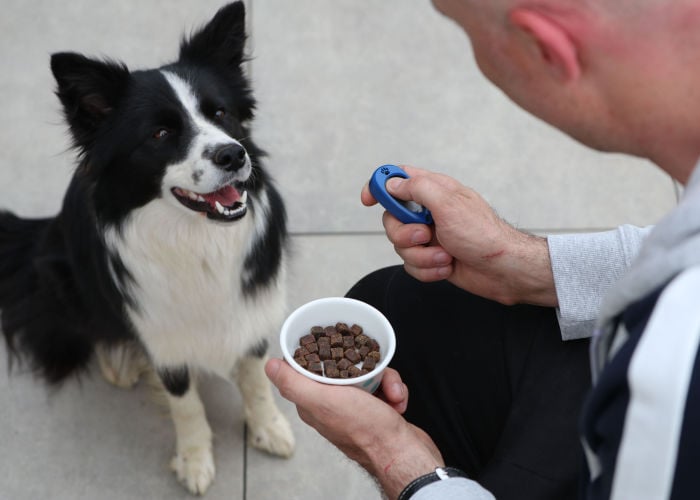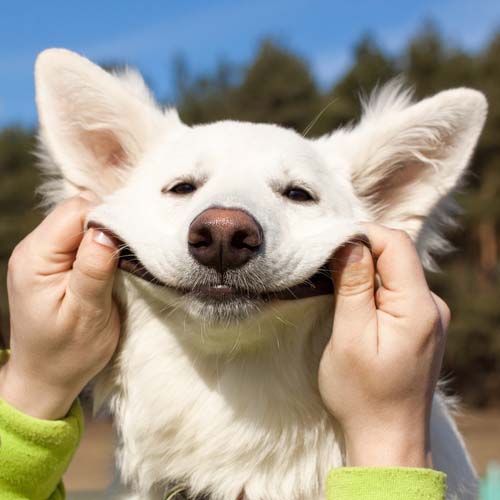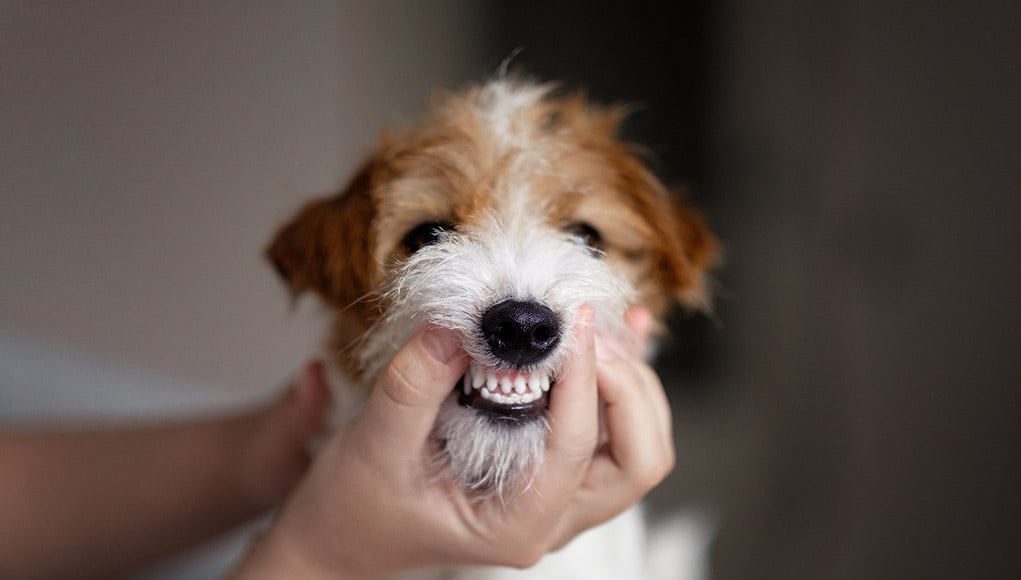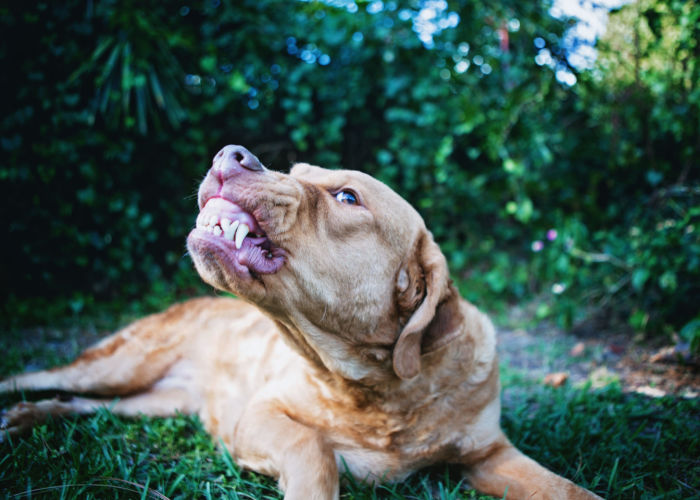
Table of Contents
- How to Teach a Dog to Smile: 6 Steps
- Reminders Before You Teach Your Dog to Smile
- How to Teach a Dog to Smile – Key Points
Dogs are indeed irresistible and charming!
Just the sight of smiling dogs can melt everyone’s heart.
But did you know you can teach dogs to smile?
You read it right!
Like any other tricks, you can make your dog smile at cameras, friends, and on occasion.
So in this blog, I’ll be discussing the steps on how to teach a dog to smile.
At the end of this post, I’ll also be sharing with you some key pointers to remember before you start training your dog.
Look forward to it later.
Without further ado, let’s start!

How to Teach a Dog to Smile: 6 Steps
Like with most training sessions with your dog, you should approach teaching smiles to your dog in a step-by-step process.
That’s why I recommend a six-step training approach to make your dog smile:
- Loading the clicker
- Prepare a cue for the dog’s smile
- Capture the smiling behavior
- Add duration between the behavior and the click
- Switching cues to the dog’s smile
- Add Distraction When Teaching Your Dog to Smile
These five actionable steps are based on other types of dog training where you mark the behavior and add difficulty along each step.

1. Loading the Clicker
The first step in learning how to teach a dog to smile is to load the clicker.
If you’ve already loaded the clicker for your dog, you can skip this step and immediately proceed to the next step.
Now, for the beginning trainers, loading the clicker is one of the fundamentals of dog training.
It’s no surprise that we’ll be using it here, too, to train your dog to smile.
To load the clicker with your dog:
- Click the clicker
- Immediately give the dog a treat
- Repeat the process about ten to fifteen times every day or until the dog gets used to the click-reward routine
- To add difficulty, click the clicker and give a one-second duration before you give the treats.
- Repeat the process to make sure that your dog will wait for the treat after the click
Why Do You Need to Load the Clicker First?
Now you may be thinking: I don’t see any smiling steps yet.
What’s clicker got to do with smile training?
Let me explain.
Clicking is when you’re teaching your dog that clicks equal treats and rewards.
So the next time you “click,” your dog will be expecting that it’ll be receiving a reward soon.
Since the click is closely related to treats, you can use it to mark desired behaviors of your dog during its training.
When you train your dog to smile, clickers are important to let your dog know its behaviors that you want to keep on doing.

2. Prepare a Cue for the Dog's Smile
Now that your clicker is locked and loaded, you can now proceed with marking the dog’s smiling behavior.
Preparing a cue for the dog's smile should be the second step in learning how to teach a dog to smile
Because here's the thing: dogs don’t typically smile!
At most, your dog will naturally flash its smile at the most random time ever.
And if your dog isn’t the type of dog to smile, then your training ends right before it even starts!
This is the biggest problem for anyone who tried teaching their dogs to smile.
What should you do about it, then?
Usually, I recommend tickling your dog to get a smile on its face.
Some of the tickle spots that I’ve discovered on most dogs are on:
- Tummy
- Armpits
- Paws
- Ears
- Neck
- Tail
If your dog has a very ticklish body, try your best to tickle it on one specific spot only.
That’s your physical cue that works the same as verbally telling your dog to smile. More about verbal cues later.
What Happens if My Dog Doesn’t Smile
If, at any cost, you can’t get your dog to smile without it getting agitated or uncomfortable, then I suggest working on alternatives and tricks instead.
Instead of smiles, perhaps you can work on other friendly gestures instead like playing bows or lying down.

3. Capture the Smiling Behavior
Whether you tickled your dog or not, your next step in how to teach a dog to smile is to mark the smile with a click.
To do this, you’re going to click the clicker immediately after the moment your dog smiles.
This is called “capturing” a behavior, which is also applicable in a lot of dog training.
Since clicks equal treats, your dog will remember that their previous behavior was a desirable one.
And if you have a physical cue like the tickling gesture, your dog will understand that they have to smile right after you tickle them.
With a few more training and clicks, the behavior will soon be imprinted on them.

4. Add Duration Between the Behavior and the Click
If you’re sure that your dog smiles after your clicks, it’s time to add a layer of difficulty to their training.
Instead of immediately clicking after your dog smiles, leave a one or two-second delay before the click.
Adding duration is a way to test if your dog will do a correct response after receiving the physical cue.
Delayed clicks also mean you’re also solidifying the behavior onto your dog.
You want to make sure that your dog responds to the tickling cue, not to the treats themselves.
RELATED: INTERVIEW: EXPERT DOG TRAINING TIPS

5. Switching Cues to the Dog's Smile
Still with me? Great!
Now, after practicing the smiling trick on the tickling cue, it’s finally time to switch the cue to a verbal one.
Transitioning to a verbal cue is your fifth step in how to teach a dog to smile
The key to switching cues is to have both signals first and then stress one cue more than the other.
Eventually, you want to remove the manual cue altogether in the command sequence.
RELATED: SCIENCE-BASED DOG TRAINING: HOW RESEARCH INFLUENCED OUR APPROACH TO TRAINING DOGS
Add the Verbal Cue
To start, use a verbal cue like “smile” or “cheese” before you tickle cue your dog to smile.
The dog will remember and add the cue as another part of the sequence in the trick.
Don’t use other verbal cues from other commands, as the dog might get confused with the same cue.
After incorporating the verbal cue to the dog, you’ll have a command sequence that starts with the verbal cue, then the physical cue, the smile, and lastly, the click.
Stressing the Verbal Cue
Now that both the verbal and the tickle cues are in place, it’s time to stress the verbal cues more than the tickle one.
Your goal should be that your dog will respond better to verbal cues rather than manual cues.
To stress the verbal cue, make the tickle shorter and less frequent.
If you’re touching its tickle spots for three to four seconds, shorten it to two seconds.
At the same time, always call out your verbal cue before you tickle.
This forces your dog to base its behaviors on verbal cues instead.
Gradually shorten the duration of the tickle until, eventually, you’re not tickling the dog to get it to smile anymore.
If your dog stops responding to the verbal cues or is giving out incorrect responses, it means your switching of cues has been too abrupt.
When that happens, just dial down and go back to the previous duration of the tickle cue.
Making the process gradual is the most important element for making the switch happen.
RELATED: 16 COMMANDS YOU MUST TEACH YOUR DOGS AFTER ADOPTING

6. Add Distraction When Teaching Your Dog to Smile
You can still add another layer of difficulty to your dog’s training through distractions.
For instance, if you’re doing the training with your dog inside your house, go take it outside!
Let the stimulations outside challenge the focus of your dog.
You can also take your dog to a dog park, where it’s full of people and dogs alike.

Reminders Before You Teach Your Dog to Smile
Hold up!
Before you start making all your Fidos smile, I want to share some pointers and reminders about dogs and smiles.
These pointers will help you give another view of what smiles are for your dog.
A Dog’s Smile Can Mean Otherwise!
A smiling dog does not always mean that it’s happy.
Even if your dog’s smiles are clear as day, it doesn’t guarantee that your dog is happy for the moment.
The smile can be as complicated as our smiles, so reading your dog’s body language is important throughout the training.
For instance, a “smile” paired with ears retracted and a body close to the ground doesn’t look like a happy doggo at all.
In fact, these body languages signal submissive grins, which means the dog is probably scared or extremely intimidated.
Another combination of body language is “smiles” with snarling noises and forward ears.
This body language can also come with the dog’s laser-focus eyes and tensed body.
That’s not a happy Fido; it’s an angry one!
By reading the smile with other body languages, you get to know how your dog is feeling at the moment.
And if your dog is showing signs of agitation, fear, or tension, then you should prioritize calming your dog and immediately stop the training.
Make the Training Enjoyable and Fulfilling
No owner wants to force a trick on their dogs.
You want your dog to be motivated and move not just because it was compelled to do so.
That’s why, when teaching your dog how to smile, you make the training as fun as possible.
Always sprinkle treats throughout the training, from start to finish.
And even if your dog has mastered smiling on command, don’t stop giving treats just because the training has ended!
Giving treats to your dog is basically telling them that they’re doing great.
How will you communicate praises to your dog if you remove their treats?
A Relaxed Dog is Better than a Smiling Dog
Smiling dogs are cool, but a relaxed one is better.
This is because your dog will look happier when relaxed than when it’s smiling.
Relaxed dogs also look more natural than smiling dogs.
A relaxed dog will have gestures and body language like:
- When the body is not stiff
- Profuse wagging of the tail
- Play bowing
- Soft and almost squinting eyes
- Relaxed eyelids
- Neutral floppy ears
Compare that to dogs when they smile.
Smiling dogs have tensed faces and artificial looks to how they bare their teeth.
Now you tell me which one’s better.
Smile Training Requires Patience
A lot of dog owners and starting trainers also ask how long the trick training should be for their dogs.
Basically, how long can they see results in the dog training?
The answer to that is it depends on the dog’s ability to learn.
Depending on how fast your dog can pick up a behavior, the training can last from five hours to five weeks.
Five weeks max is too long, you might say.
And I totally agree!
But this is where I ask you to be patient.
Be consistent and gradual with your training, and let the progress stack up until your dog can master the trick.
How to Teach a Dog to Smile – Key Points
Making your dog smile may seem like an impossible task, but it’s actually doable.
If you want to learn how to teach a dog to smile, you should approach it like any other command-based behavior.
Train your dog to smile systematically and be patient with waiting for results.
Make sure that your dog is comfortable throughout the training and continuously reward correct behaviors with rewards and praises.
Let your dog build gradual mastery over the trick, and eventually, you’ll be seeing your dog smile in no time!












